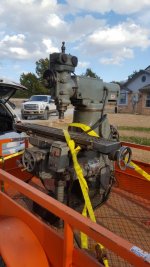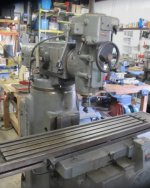kolederacer
Plastic
- Joined
- Dec 2, 2017
Follow along with the video below to see how to install our site as a web app on your home screen.
Note: This feature may not be available in some browsers.
I am considering buying it as my first mill because its cheap and im just now finishing college.
My main concerns are is this a decent machine to learn on? Is it junk and not worth it?
Any tips would be greatly appreciated. This is the first mill i have found in my budget but i dont want to waste money on junk either.
Thanks agian.
Thanks moonlight,
im going to go check it out tomorrow if possible.
Then i just have to figure how how in the hell to get it off the trailer an into the garage.
Any suggestions?
I thought maybe put it on a pallet on the trailer then pallet jack. But i have never out a mill on a pallet so i do not really know if it can take the weight?
Thanks for the help.
Be sure to look closely at the Y axis (in-out) handwheel arrangement. It looks like someone put a die-cast hardware store v-pulley and belt on there by way of Y power feed. Given the looks of the rest of that beast, I would have expected Y feed to be built in, so it might be broken. Even if not, that thing looks seriously stout. Condition, condition, condition. It looks like there there could be some serious bragging rights, if you are into that sort of thing. Just be ready to have the only KGAP-70 on your block, so to speak, so no spare parts, fixing knowledge, etc.





 ), and much of my time is spent reminding students to put on the darn glasses. It's worth finding a comfortable pair, and reminding yourself to use them. One forgetful day with a broken drill bit will literally change your life, and not for the better (unless you meet a really cute nurse in the ER).
), and much of my time is spent reminding students to put on the darn glasses. It's worth finding a comfortable pair, and reminding yourself to use them. One forgetful day with a broken drill bit will literally change your life, and not for the better (unless you meet a really cute nurse in the ER).Notice
This website or its third-party tools process personal data (e.g. browsing data or IP addresses) and use cookies or other identifiers, which are necessary for its functioning and required to achieve the purposes illustrated in the cookie policy. To learn more, please refer to the cookie policy. In case of sale of your personal information, you may opt out by sending us an email via our Contact Us page. To find out more about the categories of personal information collected and the purposes for which such information will be used, please refer to our privacy policy. You accept the use of cookies or other identifiers by closing or dismissing this notice, by scrolling this page, by clicking a link or button or by continuing to browse otherwise.
